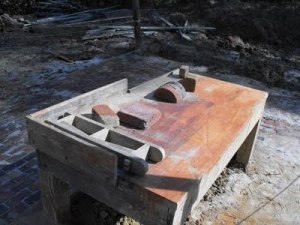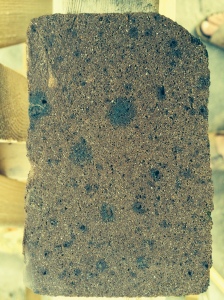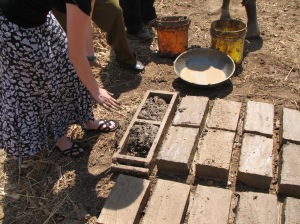The African American Heritage Project
is restoring the Charlie Clay house in the Zion Hill Historic District of Nacogdoches, TX as a community cultural center. As with most not-for-profits, they don’t have a lot of money, but they have other resources….The photos below left are from the 2011 survey update.
I got involved through Photographer Richard Orton, Treasurer of the AAHP who lamented that they didn’t have the money to proceed with the necessary foundation repairs. I asked to see the proposals and then the RFP and realized that they needed some professional assistance. Specifically the piers did not need to be replaced, just cleaned and partially repointed. With the community behind the project there will be plenty of hands to make a lot of small projects possible with a little training.

The windows have been altered with the left most having become a door with a stoop; probably after the front porch was removed. The brick piers and base of the chimney have been slathered with Portland cement.
There was one little problem…. Bricks.
With the porch missing and a couple of house piers damaged, a number of brick will be necessary for the restoration. These bricks are a really nice dark mocha color and have the distinctive fold marks of handmade bricks.
On the down side,
these are handmade bricks and are not available from Home Depot or Lowe’s.

This is actually the front of the house with the porch missing. The central doorway gives access to the center hall. The original brick piers for the porch are missing.
On the upside,
they are handmade bricks…. and not likely transported very far. Dr. Leon Young, Dir. of the Soil, Plant & Water Analysis Lab at SFASU indicates that a good brick clay is available about a foot below the surface in the backyard.
We also have Piero Fenci, Sculptor Extraordinaire, Professor of Ceramics at SFASU as a primary consultant.
Lets Make the Bricks like they were originally….
Historically these brick would have been made nearby, possibly in the backyard, but probably in a small brickyard within a mile. The sand finish and fold marks indicate that the clay was rolled on a table like bread dough using sand like flour to keep it from sticking.
When it was the right consistency it was thrown into a wood mold typically with two or four pockets for bricks. Often each pocket was filled with its own lump of clay. The clay was forced down into the corners and the excess was struck off with a tool – sometimes a metal trowel like blade was used but often a wooden spatula. The mold had no bottom and was sitting on a plank which allowed the mold to be lifted off of the formed clay and placed adjacent to create more bricks until the plank was full, at which point it was taken away to air dry for several days.

By the mid-19thc. brick was being made in brick kilns where the structure/container was reused for many firings. Photo from the internet
By the time these brick were made [1900?] most brick was fired in a kiln even if it was hand formed. Before that batches of air dried brick were stacked in what was called a clamp, which formed fire boxes and flues of the unfired brick in such a manner that when fired most of the brick would be exposed to high enough temperatures to become vitrified. These clamps were used in very small operations well into the 20th c. but the usage has become a lost art in North America.
Clamps are not the most controlled method of making brick and only about 60% are truly good brick after firing – many are under fired [salmon brick] and some are over fired [clinkers]. Within the 60% of “good” brick there are many grades of brick and they would often be sorted into face brick, common brick, etc. Depending on what sort of fuel was used, the ash especially of hardwood would adhere to the inside of the flues causing a wood ash glaze. During the 17th and 18th c. glazed headers [a by product of the firing process] were used in decorative patterns.
As with other forms of clay firing such as pottery, the fire/temperature must be brought up slowly until the moisture is completely driven out of the clay causing a discernible water smoke. Steam forming in the clay will cause the pot or brick to explode catastrophically taking the adjacent ones with it. Once the water smoke has ceased [possibly a day or two depending on the size of the clamp and moisture content of the green bricks] the temperatures can be taken up to vitrifying temperatures comparatively rapidly and held there long enough for the temperature to penetrate the clamp. It is then cooled slowly to avoid distortions of the bricks.
As the 19th c. progressed there were many advancements in the process and manufacture of brick leading to very uniform pressed brick and then extruded ceramic shapes for pipes and flue liners as well as bricks.
The Charlie Clay House bricks do not exhibit these manufacturing “improvements” and are thus excellent candidates for a local handmade process.
I suggested that the AAHP might make the bricks that were needed… so beware of suggestions that are self-nominating. Now I’m in charge of the project to make the bricks, repair the foundation, and generally get the restoration project rolling.
I have watched handmade bricks being made and even rolled some clay and threw it into a brick mold. It will take a lot of research and assistance from Piero and Dr. Young, though, to actually make good brick. Happily Dr. Young has some experience with brick making in Tanzania that will be invaluable. Anyone who would like to volunteer aid and assistance is welcome, especially all you master brickmakers.

Traditional brick clamp for firing brick directly without a formal kiln.
Tanzania brickmaking courtesy of Dr. Young
Where we are headed
As we proceed to test the local clay to determine the shrinkage rate and the size of the molds that will yield bricks of the proper size and see how the color matches we will update the blog as well as other aspects of the restoration.
Mud pies anyone?
We will definitely give several weeks warning before firing a clamp in case anyone wants to come watch/participate. We expect a lot of community participation in molding the bricks.
Tom Sawyer, you just wish you could have done this!






![Locally made [Tanzania]brick used in a wall. Tanzania brickmaking courtesy of Dr. Young](https://conservearchitecture.wordpress.com/wp-content/uploads/2014/05/bricks-in-a-wall-e1399328519115.jpg?w=273&h=262)
Awesome!! I would love to come help. It depends on money to make the trip.